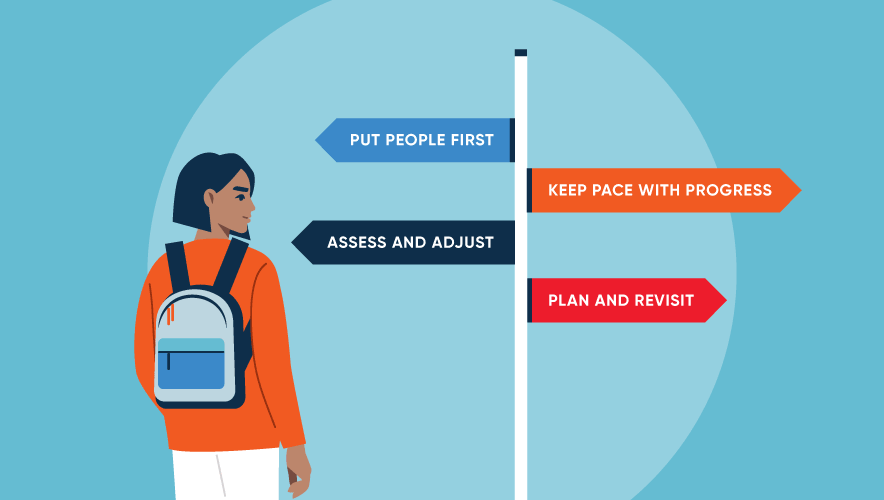The Rise of the Surveillance State
People in China are among the most surveilled in the world, taking 16 of the top 20 spots on the most surveilled cities list based on the number of cameras per 1,000 people in an annual assessment from Comparitech.
The analysis found that globally there are already more than 770 million cameras in use, and 54 percent of those cameras are in China. Taiyuan, for instance, has approximately 117 cameras per 1,000 people. China laid the groundwork for this surveillance network decades ago with community grid management and the Golden Shield Project, which helped local officials and law enforcement begin their digital transformation of existing surveillance practices.
Now, China has a vast surveillance infrastructure made up from video systems, Internet monitoring, tracking, and more. And nowhere is the power of this system more on display than in the Xinjiang region to monitor approximately 13 million Turkic Muslims—Uyghurs—through mobile apps, biometric data collection, artificial intelligence, and more.
“The mass surveillance programs in Xinjiang are China’s most visible and intrusive, but they are just one end of a spectrum,” wrote Maya Wang, China senior researcher for Human Rights Watch, in a piece for Foreign Affairs. “Chinese authorities use technology to control the population all over the country in subtler but still powerful ways. The central bank is adopting digital currency, which will allow Beijing to surveil—and control—people’s financial transactions. China is building so-called safe cities, which integrate data from intrusive surveillance systems to predict and prevent everything from fires to natural disasters and political dissent.”
China has figured out how to entwine surveillance with digital governance “not only to calibrate coercion and repression, but also to provide public services and to co-opt citizens,” says Sheena Chestnut Greitens, associate professor at the Lyndon B. Johnson School of Public Affairs at the University of Texas at Austin. “Surveillance is an overall project to make citizens highly legible to the party-state.”
Problems arise, however, when that citizen-to-state legibility is not paired with equal visibility into how the information collected via surveillance is used.
“Government transparency and accountability mechanisms are necessary for the state’s activities to be legible and accountable to citizens,” Greitens adds. “Most democracies have those transparency and accountability systems in some form, though they aren’t perfect, especially with rapidly evolving technologies and in crisis situations.”
Understanding this dynamic has become even more critical as surveillance technology used in China begins to be adopted elsewhere in the world. In an analysis for The Wilson Center, Greitens found that as of late 2019 China had exported surveillance technology platforms for use in policing and public safety to more than 80 countries.
“China’s growing major power role, and its leadership role in a number of international institutions, make it more likely that these technologies and tools will spread into use globally, even if China is not explicitly exporting some kind of full and well-defined authoritarian ‘model,’” Greitens wrote.
And if adopted by a country with an existing pattern of repression, these technologies are more likely to be used to engage in digital repression, said Steven Feldstein, author of The Rise of Digital Repression, in a panel discussion hosted by the Carnegie Endowment for International Peace.
“What I found is while China is a model for and proliferator of oppressive technologies, pinpointing China as a driver of oppression may overstate the case,” Feldstein added. “I found little evidence…that regimes not otherwise inclined to employ these tactics would employ them at China’s behest.”
In China
Wang has studied China for Human Rights Watch for nine years, but starting in 2017 her work increasingly began focusing on surveillance technology. China has a long history of low-tech mass surveillance—relying on individual informants to keep watch and inform the Chinese Communist Party (CCP) of the activities of others. With the advent of the Internet, the CCP built the infrastructure in China to support its efforts of “maintaining social control,” Wang says.
The CCP also learned how to harness new technologies that leveraged the power of the Internet and connectivity to enhance its monitoring capabilities. Through the Golden Shield Project in 2000, which is known primarily for creating China's Great Firewall, local law enforcement was given computers to digitize its processes and connect to other agencies. The project leveraged technology by outside firms, including Cisco.
China also learned how it could use other technology to conduct mass surveillance. For instance, Wang says the CCP incorporated British policing tactics of intelligence-led policing—where law enforcement collects multitudes of data to later sift through it to determine if there are any irregularities that should be investigated.
This approach became increasingly popular in China, Wang adds, and has been amped up by the adoption of new technologies such as video cameras, location tracking via smartphones, social media monitoring, drone surveillance, and more that collect vast amounts of data. Where a government official once would have relied on a person to report on a neighbor’s comings and goings, now a camera can be used to perform the same function.
“As the tech improved and became more prevalent, residents with complaints have become more visible to investigators,” Wang says.
This surveillance infrastructure was demonstrated for the outside world during the Beijing 2008 Summer Olympics. Ahead of the games, China put the nation on high alert for threats from Muslim separatist groups in the Xinjiang region following an attack on a police station that killed 16 policemen and injured 16 others, according to The New York Times.
“Even before that raid, Chinese officials had transformed Beijing into a giant fortress,” the Times reported. “Surface-to-air missiles take aim at the sky above the Olympic stadiums here. Surveillance cameras mounted on light poles scan sidewalks. Police officers search thousands of cars and trucks entering the city.
“Even civilians have been called on to strengthen the motherland: Tens of thousands of middle-aged and elderly residents wearing red armbands, reminiscent of the zealous Red Guard youth from decades ago, now patrol neighborhoods looking for even a slightly suspicious act or person.”
The Times’ sources said that the security measures were likely to remain even after the games. They were right. And in 2014, Chinese President Xi Jinping created the Central National Security Commission (CNSC)—focused on China’s internal security policies and procedures—to help enhance them.
The CNSC’s “stated aim is to improve intelligence-sharing and policy coordination, and reduce the fragmentation that prevented previous leaders from receiving timely information,” according to an article for Wiley on information capacity and social order by Greitens and Huirong Chen, Shanghai Jiao Tong University. “Other changes to China’s national-level bureaucracy under Xi, such as reorganization of the People’s Armed Police (2017-18) and passage of a National Intelligence Law (2017) to ‘unify and centralize’ intelligence systems and ‘coordinate division of labor’ have also sought to align and integrate previously fragmented intelligence and national security authorities, and reform the political-legal system responsible for internal stability.”
Shanghai also initiated a new policy—in 2014—that required streets, townships, villages, and residential communities to create “comprehensive information platforms for big-data analysis and called for dissolution of ‘information islands,’” the article said.
To help connect these former information islands, in 2017 the CCP instructed local officials to integrate their information platforms with community grid management (CGM). The success of this integration was demonstrated in China’s response to the COVID-19 pandemic when the Politics & Law Commission in Hubei had 170,000 grid workers collect data on residents to enforce a lockdown.
Another district Greitens and her coauthor studied used CGM patrol workers to report quarantine violations, count PPE supplies, trace newcomers to restricted neighborhoods, supervise food distribution to quarantined individuals and more.
“These systems collected information for timely pandemic response in the district, allowing the grids to serve as the ‘roots of the state’ during local efforts at pandemic control,” according to the article.
“The Beijing Olympics appears to have been a demonstration point for the use of surveillance technology for public safety and policing; we argued that the pandemic could serve as a similar demonstration point, but we’re unlikely to have the data to know whether that’s happened right away,” Greitens tells Security Technology.
While China has made strides in integrating its information gathering, surveillance technology, and data analysis processes, it is a large country and many of these processes are not integrated fully. But they are still enabling harm and human rights abuses, according to extensive research—including from Human Rights Watch.
“Under the ‘Strike Hard Campaign against ‘Violent Extremism,’’ the Chinese government has used technologies to bolster its repression of the Muslim minorities in Xinjiang by tracking virtually their every move, subjecting them to mass arbitrary detention, forced political indoctrination, restrictions on movement, and religious oppression,” Wang wrote in an assessment for Human Rights Watch in 2020. “Credible estimates indicate that 1 million people are being held in the region’s ‘political education’ camps.
“Governments’ impulse for surveillance is hardly new, but the Chinese government is presenting a new model of social control that, if we do not act now, may become the future for much of humanity.”
In April 2021, Human Rights Watch published a lengthy review of China’s policies in Xinjiang that are used to target Uyghurs and other Turkic Muslims in the region, calling them crimes against humanity—an alleged violation of international law.
“The specific crimes against humanity documented in this report include imprisonment or other deprivation of liberty in violation of international law; persecution of an identifiable ethnic or religious group; enforced disappearance; torture; murder; and alleged inhumane acts intentionally causing great suffering or serious injury to mental or physical health, notably forced labor and sexual violence,” according to the report.
One tool that China has used to engage in these crimes is mass surveillance to monitor and track Turkic Muslims. This is carried out through a network of informants, compulsory collection of individuals’ biometric data in medical examinations, and video systems, among other tactics.
“The Xianjing authorities have also put in place networks of automated sensory systems throughout the region, which include CCTV cameras with facial recognition, automated license plate recognition, and infrared capabilities; Wi-Fi sniffers that collect identifying addresses of networked devices; and security checkpoints and visitors’ management systems that gather identifying information,” Human Rights Watch said. “Kitchen knives in Xianjing are tracked by QR codes that include the owner’s ID number, photo, ethnicity, and address, and vehicles are subject to mandatory location trackers.”
The data collected from these sources is sent to the Integrated Joint Operations Platform (IJOP) to flag individuals considered a threat and respond to them—including sending them to detention facilities or reeducation camps. Once released from detention, these individuals are still subject to monitoring that is not limited to domestic China.
“The use of mass surveillance also extends beyond Xianjing and into the Turkic Muslim diaspora outside China, as authorities pressure them to provide detailed information about themselves, including their address, phone number, and school or workplace,” Human Rights Watch wrote. “The government has also hacked into Turkic Muslims’ smartphones around the world by embedding malicious software in apps and software frequently used by Turkic Muslims, which can ‘remotely turn on a phone’s microphone, record calls, or export photos, phone locations, and conversations on chat apps.”
China has denied the findings. In a letter sent to United Nations (UN) members in May 2021, China’s UN representative called them “lies and false allegations,” according to Reuters. The letter was sent in response to an event hosted by Germany, the United Kingdom, and the United States on the repression of Uyghur Muslims and what the UN can do in response.
Outside China
Initially, China purchased technology from foreign manufacturers to integrate into its infrastructure. Over time, however, it has developed a robust domestic manufacturing base to create the technologies it uses. Some of these companies may be owned by the CCP, but Wang says that due to a lack of transparency there is no way to know for sure.
These Chinese manufacturers have also recognized the appetite for surveillance technology outside of China. Following 9/11, many Western countries focused on the need to better identify terrorism threats and to monitor suspects.
“That narrative goes back to 9/11 and is one that [the United States] was a main propagator of that legitimized tools and repressive instruments,” Feldstein says. “We share some culpability.”
As of 2019, Greitens research found that at least 80 countries had bought surveillance technology from Chinese firms to use for policing and internal security, citing both supply- and demand-side reasons for the proliferations.
“Supply-side explanations tend to focus on these exports’ potential to gain China strategic leverage, or on China’s desire to ensure a world friendly for autocratic practices,” Greitens wrote in her Wilson Center analysis. “Chinese tech companies and adopting jurisdictions, however, tend to emphasize a governance demand that these products meet, usually related to public safety, tourism, and job creation.”
One early adopter was Nairobi, Kenya, which installed 2,000 high-definition surveillance and traffic cameras with automatic plate number recognition as part of a Huawei Safe City project. Nairobi purchased the system in 2014, prior to Pope Francis’ visit in 2015.
Greitens’ analysis found that Nairobi’s regional crime rate dropped 46 percent following the introduction of the system. This success encouraged Huawei to market similar systems to other Kenyan cities, saying they were effective in reducing crime. But after 2015, Nairobi’s crime rate went up for several years and Huawei changed its marketing approach.
“The lesson from Kenya is that there is reason to question the marketing pitch that Huawei and others have used, which argues that Chinese surveillance tech provides a public good by enhancing public safety and thereby job creation and economic growth,” Greitens wrote.
Huawei also worked with Mandalay, Myanmar, in 2019 to implement a Safe City project that included CCTV cameras with AI and facial-recognition technologies. Mandalay authorities said they were adopting the system to enhance public safety. It is unclear how effective the system was in reaching that goal, but Greitens found that it was used by the Myanmar military in 2021 to crackdown on protestors following a coup.
“Surveillance technology has played a key role in the junta’s crackdown, including technologies that unlock, recover, and decrypt data from mobile phones, Israeli surveillance drones, and other digital forensic technology (not just from China, but from a number of Western countries as well),” Greitens wrote.
Chinese firms are not selling surveillance equipment with a mandate that they be used in the same way they are in China. In research for his book on digital repression, Feldstein said that when democracies adopt these technologies, they may have an incremental effect on repression that is far different from the impact on Uyghurs in Xianjiang.
“You have to ground your understanding of what digital repression means in the country—the leaders and actors dealing with it and confronting these tools on a day-to-day basis,” Feldstein explained.
For instance, to create a powerful digital repression state a nation would need to have the technical capability to take information gathered by a surveillance system and make it actionable. Many nations lack the resources needed to carry this out, so instead they may adopt smaller, disparate solutions that could infringe on individual’s rights but are not integrated in a way to engage in systemic repression.
Lindsey Sheppard, International Security Program fellow at the Center for Strategic & International Studies (CSIS), agrees with Feldstein’s assessment.
“China has this export market for surveillance technology; and while it may not be directly exporting its model as a cookie cutter, what it does offer to many nations is to say, especially if it’s a nation that has repressive tendences or tactics, we’re going to give you the tech to continue your repressive actions,” she explains. “China is spreading this capability globally in a way that is concerning. We’ve seen concerns about it—even from U.S. suppliers—having to be more mindful and more aware of what are the end uses of their products as more nations seem to be looking towards using digital technologies for certain aspects of population repression.”
This is creating a “crisis of conscious” for some companies that do business in nations that have authoritarian tendencies, Sheppard says, referencing a recent Times analysis of Apple’s business dealings in China and the impact they have had on the population there.
“If you’re a computer vision company, and you make cameras that can detect movement of people, you now have to think through more carefully: Where is this product going? Is this going to be a benign use or a problematic use?” she adds. “It’s requiring companies to be a bit more aware.”
It’s also putting pressure on global leaders to make policy catch-up to technology. Surveillance technology is not well-regulated and citizen rights are not well-protected internationally, Greitens says.
“I think it’s important that the United States work with like-minded democracies, and in some key organizations, to propose a set of standards on surveillance technology that include safeguards for privacy and civil liberties,” she explains. “The trick is going to be getting buy-in from enough countries to get the strategy adopted, without watering down the standards such that they become meaningless. And it’s also possible that the United States’ own debates over technology policy will complicate this task.”
To prevent China from increasing its hold on the market, Wang has suggested that the United States reform its own surveillance practices and work with other nations to create global standards for tech firms to abide by.
“This contest between the United States and China is not simply a competition of technological prowess,” Wang wrote in a piece for Foreign Affairs. “A convincing democratic alternative to the Chinese government’s model should require technological developments to meet human rights standards, protect privacy, and foster public interest and civic participation.”
She recommends the United States reform its national security surveillance laws and regulate how companies collect, analyze, and share personal data. It should also introduce biometric data protections and use sanctions against Chinese companies—and others—that enable abuse of human rights.
But when asked if she’s optimistic about any of these recommendations becoming reality, Wang tells Security Technology that she is not.
“In terms of privacy legislation, the moment is right. There is concern around the power of major big tech that could be an opportunity when it comes to protection of privacy,” she says. “But breaking up big tech doesn’t mean the protection of privacy.”
Megan Gates is editor-in-chief of Security Technology. Connect with her at [email protected]. Follow her on Twitter: @mgngates.












